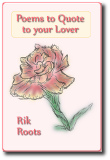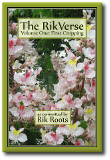
Back soon ...
(Photo courtesy of this website)
Essential reading for all students of the force of nature currently operating as Rik Roots. Here you will read Rik as he happens to other people, objects and occasional lines of verse. Complementary ice cream is served to selected guests on alternate Thursdays. Visitors are reminded not to complain about the kitten photos. No spitting, and no refunds!
Accessory
Such a stupid hat.
Not you, the way it falls
across your eyes, the brim
sieving dust mites;
a swatch of orange
without feathers
- felt, maybe,
or shoddy.
So many rags and snags
rolled tight to fit
in this cupboard.
Dress up for me.
Let fall your hat, your shirt -
wear me, tonight, my supple
leather laced tight
to you, your fingers
my wicker crown.
Coots
Look at you, sloven shortwings, your nests
a dereliction of twigs poked in sludge
beyond the gardened soils of the pond.
Tourists gather to watch you fornicate,
his grub-chain toes scouring oil from plumes
as her head dives to avoid the bloodeye leer.
Last year I watched you hatch four cuties,
bundles of floating chirrups, watched you peck
each to death in turn when you tired of them.
Still you flirt your jaundiced legs, squabble
as you wave your saddle-white heads like liars
while scrumping breadcrumbs from the geese.
The RikVerse
The RikVerse website is a living book of poems, regularly revised and updated with new work as the muse I ride sees fit
22 Facets of my Father
A set of poems loosely inspired by the Major Arcana tarot cards, investigating the relationship between a father and a son.
hardcopy: £2.49 + p&p
Play Time
These 22 poems are some of my earlier work, from the poems that survived the post-puberty bonfire up to around the turn of the century.
hardcopy: £2.49 + p&p
From Each Skull, A Story
None of the people described in these poems are real – they've all emerged fully formed from my imagination. Feel free to draw whatever conclusions you like from this admission.
hardcopy: £1.99 + p&p
Poems to Quote to your Lover
In this collection, I am proud to present you with some love. These poems deal with loves and relationships in all their wonderful and woeful manifestations.
hardcopy: £1.99 + p&p
The RikVerse: volume 1
Includes all four of the above chapbooks, at half the price!
hardcopy: £4.99 + p&p
The RikVerse Website
The Kalieda Encyclopaedia
The Rikweb forum
Rik's Issuu page

